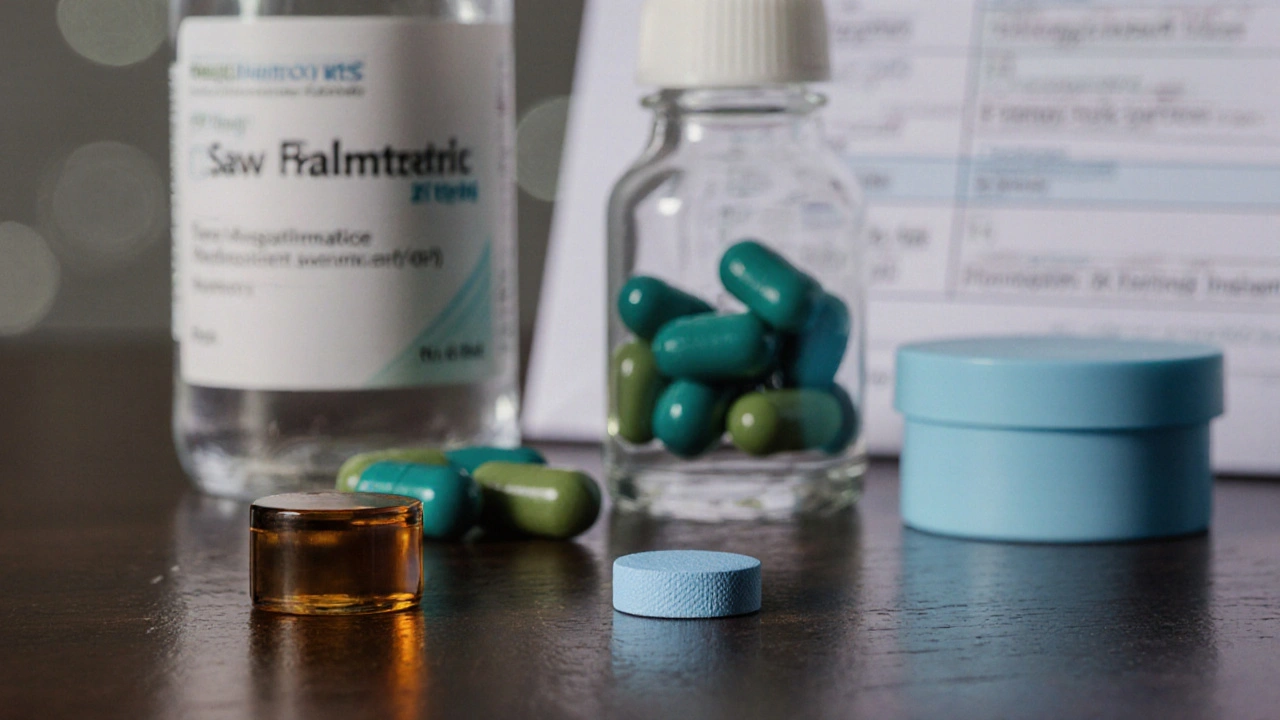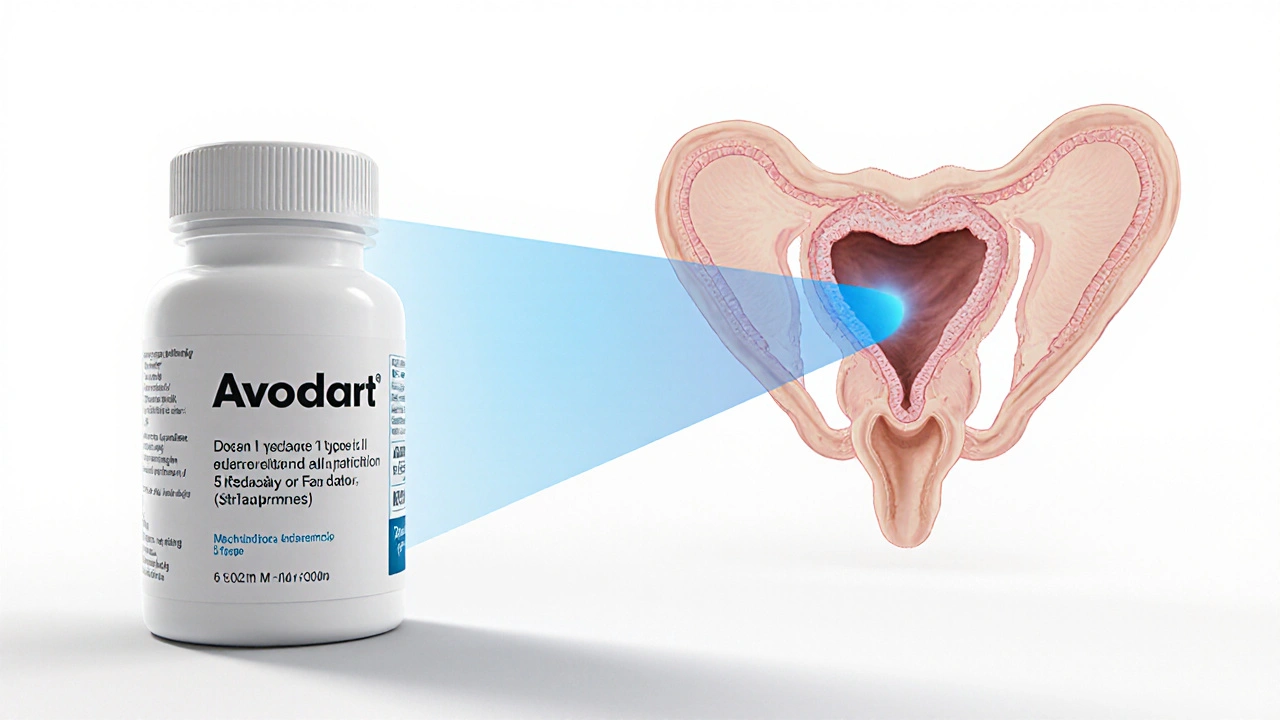BPH & Hair Loss Treatment Decision Tool
Answer these questions to get a personalized recommendation for BPH or hair loss treatment.
Your Recommendation
If you’re weighing Avodart against other options, this guide breaks it down.
Key Takeaways
- Avodart (dutasteride) blocks both type I and II5‑α‑reductase enzymes, offering strong BPH relief.
- Finasteride blocks only typeIIenzyme, making it a cheaper but slightly less potent alternative.
- Herbal saw palmetto works for mild symptoms but lacks robust clinical evidence.
- Topical minoxidil treats hair loss, not prostate enlargement, and can be combined with oral drugs.
- Cost, side‑effect profile, and specific health goals decide the best fit.
What Is Avodart?
Avodart is a prescription medication whose active ingredient is dutasteride. It belongs to the class of 5‑α‑reductase inhibitors and works by reducing the conversion of testosterone to dihydrotestosterone (DHT). Lower DHT levels shrink the enlarged prostate, relieving urinary symptoms caused by benign prostatic hyperplasia (BPH). Avodart is also approved in many countries for treating androgenic alopecia (male pattern hair loss) because DHT drives hair‑follicle mini‑aturization.
Typical dosage for BPH is 0.5mg taken once daily; for hair loss some clinicians prescribe the same dose, though off‑label use varies. Clinical trials show a 30‑40% reduction in prostate volume after one year, and a 20‑30% improvement in hair count compared with placebo.

Primary Alternatives to Avodart
Below are the most common alternatives, each with a brief definition and the role it plays in prostate or hair health.
Finasteride is another 5‑α‑reductase inhibitor, but it blocks only the typeII enzyme. It’s sold as Proscar (5mg) for BPH and Propecia (1mg) for hair loss.
Saw Palmetto is a plant extract often marketed as a natural BPH remedy. It contains fatty acids that modestly inhibit 5‑α‑reductase, though potency is far lower than prescription drugs.
Minoxidil is a topical vasodilator approved for androgenic alopecia. It stimulates blood flow to hair follicles, promoting growth, but it does not affect prostate tissue.
Tamsulosin is an alpha‑blocker that relaxes smooth muscle in the prostate and bladder neck, improving urine flow without altering DHT levels.
Benign Prostatic Hyperplasia (BPH) is a non‑cancerous enlargement of the prostate gland, common in men over 50, that can cause frequent or weak urination.
Androgenic Alopecia refers to the pattern of hair thinning driven by DHT’s effect on susceptible follicles.
Side‑by‑Side Comparison
| Attribute | Avodart (dutasteride) | Finasteride | Saw Palmetto | Minoxidil (topical) |
|---|---|---|---|---|
| Mechanism | Inhibits typeI&II5‑α‑reductase | Inhibits typeII5‑α‑reductase | Weakly inhibits 5‑α‑reductase (natural compounds) | Vasodilation → increased follicle blood flow |
| FDA‑approved uses | BPH, male pattern hair loss (off‑label in US) | BPH (Proscar), hair loss (Propecia) | Dietary supplement for mild BPH | Hair loss |
| Typical dose | 0.5mg once daily | 5mg (BPH) or 1mg (hair) once daily | 320mg extract two to three times daily | 2% solution twice daily (or 5% for men) |
| Efficacy for BPH | 30‑40% reduction in prostate volume; 50‑60% symptom relief | 20‑30% volume reduction; 40‑50% symptom relief | Variable; modest symptom improvement in ~30% of users | Not applicable |
| Efficacy for hair loss | 20‑30% increase in hair count (off‑label) | 15‑25% increase (Propecia) | Limited evidence; occasional modest benefit | 30‑40% increase in hair density |
| Common side effects | Sexual dysfunction, breast tenderness, rare gynecomastia | Decreased libido, erectile dysfunction, ejaculatory issues | Gastro‑intestinal upset, mild headache | Scalp irritation, unwanted facial hair |
| Average monthly cost (US) | $70‑$110 (brand) | $30‑$60 (generic) | $20‑$35 (supplement) | $25‑$45 (over‑the‑counter) |
How Do They Stack Up?
Efficacy Matters First
When the primary goal is shrinking an enlarged prostate, Avodart’s dual‑enzyme blockade gives it a clear edge. Studies show it outperforms finasteride by roughly 10‑15% in prostate‑volume reduction. For hair loss, finasteride still holds the clinical crown because its dosage is optimized for follicle DHT suppression, while Avodart’s off‑label use yields comparable but less predictable results.
Safety and Tolerability
The biggest complaint across 5‑α‑reductase inhibitors is sexual side effects. Avodart’s broader inhibition means a slightly higher odds ratio for decreased libido (about 4% vs 2% for finasteride). Saw palmetto’s side‑effect profile is mild, making it attractive for men who can tolerate modest symptom relief. Minoxidil avoids systemic effects but can cause scalp irritation, which some users find bothersome.
Cost Considerations
Insurance usually covers finasteride for BPH, while Avodart often falls under a higher co‑pay tier. For patients without insurance, generic finasteride offers the best price‑to‑effectiveness ratio. Saw palmetto is the cheapest option but may require a higher pill burden.
Convenience and Administration
All oral options are once‑daily pills, but minoxidil adds a twice‑daily topical routine. Tamsulosin, while not a DHT reducer, provides rapid symptom relief within days and can be paired with a low‑dose 5‑α‑reductase inhibitor if urgency is a major concern.

Which Option Suits Your Situation?
Use the following quick decision guide:
- Predominant BPH symptoms (large prostate, urinary flow issues): Avodart if you need maximal shrinkage and can accept higher cost; finasteride if budget matters; tamsulosin if immediate relief is needed.
- Primary concern is hair loss: Finasteride (Propecia) remains first‑line; Avodart is an alternative if you’re already on it for BPH or prefer a 0.5mg dose; add minoxidil for synergistic effect.
- Mild, occasional urinary symptoms and prefer natural approach: Saw palmetto can be tried for 3‑6months before moving to prescription.
- Concerned about sexual side effects: Discuss low‑dose finasteride (0.5mg) or consider a ‘watchful waiting’ approach with lifestyle changes (diet, fluids, pelvic exercises).
Talking to Your Doctor
Bring these points to the appointment:
- Current symptom severity (IPSS score if known).
- Any prior experience with 5‑α‑reductase inhibitors.
- Your primary goal-prostate size reduction, urinary relief, or hair preservation.
- Potential drug interactions (e.g., other anti‑androgens, anticoagulants).
- Willingness to monitor PSA levels regularly, as dutasteride can lower PSA and mask prostate‑cancer detection.
Ask about baseline labs, follow‑up timing (usually 3‑6months), and what to do if side effects arise. Most clinicians will start with the cheaper finasteride and switch to Avodart only if response is inadequate.
Frequently Asked Questions
Can I take Avodart and finasteride together?
Combining the two isn’t recommended because they work on the same pathway and increase the risk of side effects without clear added benefit. Doctors usually pick one or the other based on effectiveness and tolerance.
How long does it take to see results for BPH?
Typical improvement in urinary flow appears after 3‑6months of consistent dosing. Maximum prostate‑size reduction may take up to 12months.
Will Avodart affect my PSA test results?
Yes. Dutasteride can lower PSA by about 50%. Doctors usually adjust the PSA reading by multiplying the observed value by 2 to gauge cancer risk.
Is saw palmetto safe to use with prescription meds?
Generally safe, but it can modestly affect blood‑clotting pathways. If you’re on anticoagulants, talk to your physician before adding it.
Can I stop Avodart once symptoms improve?
Stopping the drug usually leads to a rebound in DHT levels, and symptoms can return within weeks. Long‑term maintenance is typical for BPH management.

John Babko
October 13, 2025 AT 18:39Look, you’re paying premium for Avodart when a generic finasteride does the job!!! If you’re proud of the American healthcare system, demand cost‑effective meds!!!
Stacy McAlpine
October 18, 2025 AT 23:59Finasteride’s cheaper price tag makes it a solid first‑line choice for most guys dealing with BPH or hair loss – especially if you’re watching the wallet.
Roger Perez
October 24, 2025 AT 05:19Avodart really shines when you need the maximum shrinkage of the prostate.
Its dual‑enzyme block forces DHT down across the board.
That means you often see a 30‑40% reduction in prostate volume after a year.
The trade‑off is a slightly higher chance of sexual side effects compared with finasteride.
For many men, that risk is acceptable because the urinary flow improves dramatically.
If hair loss is also on your radar, Avodart can give you comparable gains to finasteride.
The dosage stays at a convenient 0.5 mg pill once daily, so compliance isn’t an issue.
Insurance coverage, however, tends to favor the cheaper generic finasteride, leaving you with a higher co‑pay for Avodart.
Some doctors start patients on finasteride and only switch if the response is lukewarm.
Saw palmetto might look appealing as a natural option, but the evidence for meaningful BPH relief is weak.
Minoxidil, on the other hand, does nothing for the prostate – it’s purely a scalp treatment.
Tamsulosin can give rapid symptom relief but doesn’t shrink the gland, so it’s often paired with a 5‑α‑reductase inhibitor.
Monitoring PSA levels is crucial because dutasteride can cut PSA in half, potentially masking early cancer signals.
Lifestyle tweaks – reducing caffeine, staying hydrated, and pelvic floor exercises – can complement any medication.
Bottom line: weigh the cost, side‑effect tolerance, and whether you need a one‑stop solution for both BPH and hair loss. 😊
michael santoso
October 29, 2025 AT 10:39Cost matters more than brand hype.
M2lifestyle Prem nagar
November 3, 2025 AT 15:59Try saw palmetto first; it’s cheap and has few side effects.
Jonathan Seanston
November 8, 2025 AT 21:19Great rundown! I’ve been on Avodart for six months and the bathroom trips have dropped dramatically 😊
Sukanya Borborah
November 14, 2025 AT 02:39The finasteride economy‑driven hype ignores real‑world adherence issues – you still gotta swallow a pill daily, bro.
Stu Davies
November 19, 2025 AT 07:59Sounds frustrating, but consistency really is the key to see benefits 👍
Nadia Stallaert
November 24, 2025 AT 13:19Did you know the pharma giants deliberately suppress cheap natural alternatives like saw palmetto to keep us dependent on pricey patents???
Greg RipKid
November 29, 2025 AT 18:39From a practical standpoint, I’d start with finasteride and only move up if symptoms persist.
John Price Hannah
December 4, 2025 AT 23:59But why settle for “only if” when you could grab the most potent option right away!!! The prostate won’t wait!!!
Echo Rosales
December 10, 2025 AT 05:19Honestly, the whole 5‑α‑reductase debate feels overblown; lifestyle changes often outperform meds.